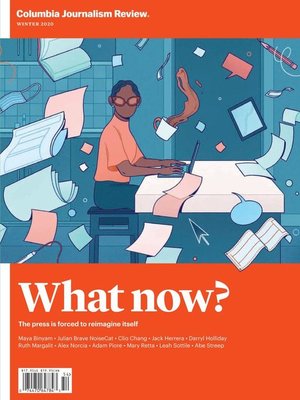Columbia Journalism Review
magazine ∣ Winter 2020 · Columbia Journalism Review

Sign up to save your library
With an OverDrive account, you can save your favorite libraries for at-a-glance information about availability. Find out more about OverDrive accounts.
Find this title in Libby, the library reading app by OverDrive.



Search for a digital library with this title
Title found at these libraries:
| Library Name | Distance |
|---|---|
| Loading... |
Columbia Journalism Review (CJR) encourages and stimulates excellence in journalism in the service of a free society. Published by Columbia University’s Graduate School of Journalism, CJR examines press performance as well as the forces that affect it. The bimonthly magazine offers a deliberative mix of reporting, analysis, criticism, and commentary.
Columbia Journalism Review
Contributors
What We’ve Learned • The biggest issue facing the United States media is that it tends to be chauvinistic.
An industry in flux
The First Responders
The Influencer Commentariat
Back to the Community
Apocalypse Then and Now
The Substackerati • Did a newsletter company create a more equitable media system—or replicate the flaws of the old one?
What We’ve Learned • It doesn’t matter how many New York Times stories you read about the virus spreading into rural areas; you need a local news source reporting on someone that you know, or your kids know.
How are we feeling? • This year delivered a professional paradox: the coronavirus highlighted the importance of a vibrant press, yet the crisis introduced new levels of instability and viral disinformation, which piled on to the stresses of an industry already overloaded. To better understand how members of the media are faring, the International Center for Journalists and Columbia’s Tow Center for Digital Journalism began the Journalism and the Pandemic Project, surveying news workers around the world. The initial findings, from English-speaking respondents in 125 countries, provide a snapshot of the mood… Not great.
For Pueblo • What happened when John Rodriguez, a publisher, sought public funding
Cover Story • In the fall of 2010, Mathias “Mo” Valdez, a silkscreen artist, designed a poster that read “WE ARE PUEBLO.” It quickly became a local rallying cry, and Valdez went on to create every Pulp cover but one.
Tax Dollars at Work • In recent years, with the journalism business increasingly untenable, there have been calls for public investment across the country, at the local and federal level.
What We’ve Learned • The early confusion over the masking directives was contradictory information for a very suspicious, negatively polarized community, and it undercut public health later on.
Out of Nowhere • What’s lost and won as newsrooms close their offices for good
Up, Up, and Away
What We’ve Learned • A science journalist’s default mode is writing about small updates and individual studies. This is basically what I’ve been doing for my entire career.
New Money
“We need to radically redefine who we are serving.” • Jack Herrera speaks with Tasneem Raja, editor in chief of The Oaklandside
Diversity Work • Media companies haven’t made newsrooms inclusive. Can unions?
What We’ve Learned • The disparities exacerbated by the pandemic and highlighted by the protests didn’t start in March, and they’re not going to end with a vaccine.
Do It Yourself • The persistence of indie mags as pure expressions of taste.
Ideal Filler • The New York Times and the unending blizzard of takes
What We’ve Learned • We’re not connecting the dots between the pandemic and the climate crisis enough.
Skin in the Game • Enrique Abeyta, a former hedge-funder, goes all in on metalhead media
Bad Boys • When investors show up, promising to reinvent or save the news industry, it often portends chaos. Some of the most notorious figures have cost thousands of journalists their jobs.
What We’ve Learned • Food media has a good lesson to learn from the pandemic. Our food systems are kept afloat by unsustainably low wages, by undocumented workers, by food that is not ecologically sound.
End...







